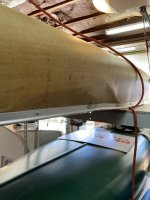I bought a damaged Wenonah Solitude and I'm planning to repair the damage and refinish the surface. I'll post some pictures of the damage when I get a few minutes. Overall, the hull is UV expesed so its chalky and dry. Both of the aluminum gunnels are bent and cracked. Some of the ribs are cracked. There is a half moon shaped "dent" in the side of the boat that is about 6" by 24" by 1/2" deep. There are no broken fibers at any of the cracks. It sounds like a lot but its all pretty simple damage. I only paid $350 for it and I wanted a light boat but not enough to pay $2500 for one.
Here's my current plan. Its definitely subject to change based on suggestions here. Please give me some constructive suggestions on what may not be a good idea.
1) order new gunnels from Wenonah - already did that, picked them up yesterday - a 400+ mile trip -"free shipping"
2) remove old gunnels and let hull pop back to shape. I think that it will.
3) If the sheer line doesn't have a fair curve when the gunnels are removed I'll cut some temporary wood strips to make it so
4) lightly sand the hull with maybe 120 grit sandpaper - not sure about that
5) repair the damage (hull and ribs) with one layer of 4 oz S-glass and Raka - UV inhibited epoxy (I know that Wenonah uses polyester but its nasty stuff)
I'll probably put two layers of s=glass on the ribs. I really havent decided for sure on epoxy vs polyester. I repaired a fiberglass camper recently with polyester and it was not a great experience since one 2 oz setup of polyester just flashed on me for no particular reason. It made an ugly mess.
6) refinish the entire canoe with an epoxy or polyester top coat. I plan to tint the topcoat gold to even out the aged and mottled look.
7) install the new gunnels - I'll probably make a masonite template of the hole layout using the old holes in the hull as a template somewhere along the way.
Additional items: I splurged and bought black anodized gunnels because they look better to me. I will probably paint the thwarts to match. I will probably add kevlar skid plates. Also, the previous owner put in an incredibly ugly PVC bass boat seat. Its gotta go. I'm working out some options in my head. Wenonah told me that I COULD hang a traditional seat with their seat bracket but they didn't highly recommend it due to the tumblehome on the solitude and the light hull. They aren't selling tractor seats currently due to supply chain problems - other parts of the seat track are missing too. Anyhow I'll think of something but any seat suggestions are appreciated.
Here's my current plan. Its definitely subject to change based on suggestions here. Please give me some constructive suggestions on what may not be a good idea.
1) order new gunnels from Wenonah - already did that, picked them up yesterday - a 400+ mile trip -"free shipping"
2) remove old gunnels and let hull pop back to shape. I think that it will.
3) If the sheer line doesn't have a fair curve when the gunnels are removed I'll cut some temporary wood strips to make it so
4) lightly sand the hull with maybe 120 grit sandpaper - not sure about that
5) repair the damage (hull and ribs) with one layer of 4 oz S-glass and Raka - UV inhibited epoxy (I know that Wenonah uses polyester but its nasty stuff)
I'll probably put two layers of s=glass on the ribs. I really havent decided for sure on epoxy vs polyester. I repaired a fiberglass camper recently with polyester and it was not a great experience since one 2 oz setup of polyester just flashed on me for no particular reason. It made an ugly mess.
6) refinish the entire canoe with an epoxy or polyester top coat. I plan to tint the topcoat gold to even out the aged and mottled look.
7) install the new gunnels - I'll probably make a masonite template of the hole layout using the old holes in the hull as a template somewhere along the way.
Additional items: I splurged and bought black anodized gunnels because they look better to me. I will probably paint the thwarts to match. I will probably add kevlar skid plates. Also, the previous owner put in an incredibly ugly PVC bass boat seat. Its gotta go. I'm working out some options in my head. Wenonah told me that I COULD hang a traditional seat with their seat bracket but they didn't highly recommend it due to the tumblehome on the solitude and the light hull. They aren't selling tractor seats currently due to supply chain problems - other parts of the seat track are missing too. Anyhow I'll think of something but any seat suggestions are appreciated.
Last edited:















